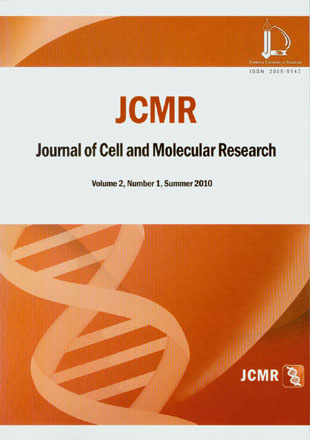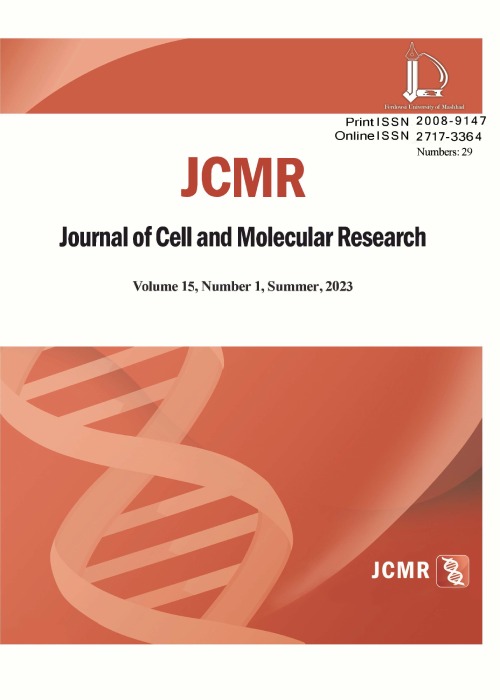فهرست مطالب

Journal of Cell and Molecular Research
Volume:2 Issue: 1, Summer and Autumn 2010
- تاریخ انتشار: 1389/11/18
- تعداد عناوین: 7
-
-
Page 1Trehalose is the alpha, alpha-1,1-linked glucose disaccharide. Its metabolism is found in a wide variety of organisms and is seen as evolutionary old. Trehalose metabolites are however present at only very low concentrations and their role in plants are not understood. The physiological effects of 100 mM trehalose on growth and carbon allocation in seedlings are characterized in this paper. Trehalose feeding to Arabidopsis thaliana elicits strong responses. On 100 mM trehalose, seedlings germinate and extend cotyledons but fail to develop primary leaves. The primary roots do not grow beyond 2-3 mm and there is not any starch in root tips. In light, growth arrest on 100 mM trehalose can be rescued by exogenous supply of metabolisable sugar. Trehalose feeding results in anthocyanin accumulation and chlorophyll reduction. Trehalose causes cells of the root extension zone to swell and lysis. Trehalase expression analysis showed, WT seedlings grown on trehalose have 10-fold induced AtTRE1 expression compared to sorbitol treatment.
-
Page 10This study examines the assumption that plant resistance to herbivory has fitness costs. To assess costs, I used the standard method of determining whether there is a significant negative genetic correlation between the resistance character and damage in the presence of herbivory and with fitness in the absence of herbivory.Seeds of five plants from four genotypes of Arabidopsis thaliana were sown under controlled conditions in a growth chamber. Half of the resulting two months-old rosettes were used for glucosinolate analysis and for herbivory assessment. The other half was transplanted into an enclosure in the natural habitat of this plant and fitness (fruit number) was measured after harvesting the plants. Caterpillars from Spodoptera exigua were obtained from a lab culture for herbivory assessment. Two second instar caterpillars from S. exigua were placed on each of rosettes. Larval weight of caterpillars was measured after 5 days. One hundred mg dry mass of leaves of 5 rosettes of each genotypes were used for HPLC analysis. There were genetic variations in types and quantities of glucosinolate between genotypes. The results from herbivory assessment showed that the larval weight of S. exigua fed on some genotypes was significantly lower than others, and therefore there was genetic variation in resistance to herbivore for A. thaliana genotypes. Statistical analysis showed that the larval weight of S. exigua was negatively correlated with total glucosinolate concentration and with fruit number. Therefore under the condition of this experiment, glucosinolstes reduced damaged by S. exigua and exhibited significant fitness costs.
-
Page 15We used various screening techniques, clustering, decision tree and generalized rule induction (association) (GRI) models and molecular phylogenic relationship to search for patterns of halophi-licy and to find features contribute to halolysin salt stability. We found Met was the sole N-terminal amino acid in halolysin proteins, whereas other amino acids found at this position of oth-er proteases and termitase. Eighty-three protein features were shown to be important in feature selection modeling, and just one peer group with an anomaly index of 2.42 declined to 1.87 after being run using only important selected features. The depth of the trees generated by various de-cision tree models varied from 1 to 5 branches. The number of peer groups in clustering models was reduced significantly (p
-
Page 29Potato (Solanum tuberosum L.) auxiliary buds c.v. White Desiree were cultured in MS medium containing 0, 50, 100, 150 and 200 μM concentrations of silver thiosulfate (STS) under in vitro condition. After eight weeks, the effect of silver ions (Ag+) in the form of silver thiosulfate complex (STS), as an ethylene action inhibitor, on chlorophyll contents of leaves, ascorbate peroxidase, guaiacol peroxidase and catalase activities of roots andleaves were studied. Application of silver (STS) in culture medium increased chlorophyll content comparing to the control plants significantly. After treatments of potato plants with STS, ascorbate peroxidase and guaiacol peroxidase activities in roots were higher than shoots while catalase activity was higher in leaves than roots.However, increasing of STS concentration in the culture medium resulted in higher activities of antioxidant enzymes with some variations.
-
Page 35Thrips tabaci Lindeman is an extensively distributed pest insect in many areas that affects plants through direct feeding and at the same time, it makes damage as a vector of different viruses. As a basic first step to control pests is authentic identification, but the inability to determine morphological characters of thrips species makes this process very difficult. For creating an identification key for T. tabaci, an economically important species present in Iran, four individuals were selected from four different sites of Mashhad and thevicinity, each as a separate population. The method was based on nucleotide sequencing analysis of the mitochondrial cytochrome C oxidase I (COI) gene. Phylogenetic analyses conducted by the neighbor-joining method yielded almost identical phylogenetic reconstructions of trees that separated thrips based on the geographic origin. Molecular data indicate that different thrips species are located in distinct groups. Theseresults show that molecular keys can be a useful method to provide much-needed information on thrips identification for pest management officers and quarantine purposes.
-
Page 42In recent years, several plant species have been used as bioindicators, and several tests have been developed to evaluate the toxicity of the environmental contaminants. In this study, the root length and DNA band pattern of root tips in maize (Zea mays L.) seedlings were exposed at different concentration of cadmium pollutant (40and 80 mg L−1). The results indicated that the root length of maize seedlings reduced with an increasing cadmium concentration. A random amplification of polymorphic DNA (RAPD) analysis from the extracted DNA was carried out using twenty three 10-base pair random primers. Eleven primers produced 72 bands between 221-3044 base pairs in gel electrophoresis. DNA damage became evident as the presence and/or absence of DNA fragments in the treated samples compared to the control groups. The number of disappearing bands in profiles increased from 33 at 40 mgL-1 of cadmium concentration to 45 after exposure to 80 mg L−1 cadmium concentration compared to total bands in control. Three new bands appeared in 40 mgL-1 of cadmium concentration but five in 80 mgL-1 of cadmium concentration. The results showed that RAPD analysis couldbe a useful tool for detection of genotoxic effects of cadmium toxicity on plants.
-
Page 49The genus Onobrychis belongs to family Fabaceae and has about 130 species throughout the world.Onobrychis sect. Hymenobrychis with nearly 14 species in Iran is one of the important sections of the genus.The chromosome number and meiotic behaviour were studied in two populations of Onobrychis chorassanica belonging to this section native to Iran. This report is the first cytogenetic analysis of this taxon. Both populations are diploid and possess 2n = 2x = 14 chromosome number, consistent with the proposed base number of x = 7. Although these taxa displayed regular bivalent pairing and chromosome segregation atmeiosis, some meiotic abnormalities were observed. The meiotic abnormalities included varied degrees of chromosome stickiness including B-chromosome, cytomixis, asynchronous nucleus, fragmented chromosomes, occurrence of laggard chromosomes, chromosome bridges, desynapsis, micronucleous and tripolar cells.


